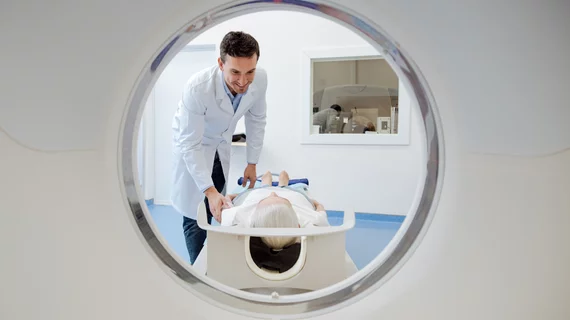The shielding debate has been back in the news recently, following a prominent piece, published in the New York Times last month. Now, Dutch researchers are also weighing in, urging radiologists to discontinue the use of such protections in pelvic imaging.
Debate about this topic has heated up recently in the Netherlands, with differing recommendations on whether it’s still necessary. Wanting to clear any confusion, experts from the Maastricht University Medical Center conducted an exhaustive review of the literature and history on this imaging practice, dating back its inception in the early 1900s.
The upshot? Advancements in technology and dosage limitation mean it’s safe to abandon shielding in pelvic radiology, according to their analysis, published Feb. 7 in Insights into Imaging.
“Today, using a modern and optimized x-ray system, gonad shielding can be safely discontinued for women,” concluded the team, led by Cécile Jeukens, with the university’s Department of Radiology and Nuclear Medicine. “For men, there might be a marginal benefit, but potential negative side effects may well dominate. Discontinuation of gonad shielding seems therefore justifiable.”
To reach their conclusions, Jeukens and colleagues scoured publications for any developments in shielding or insights into the effect of ionizing radiation on gonads. They noted that radiologists first used shielding to prevent male sterility in 1905, but the practice was shelved as the field worked to reduce radiation dosage.
However, the practice resurfaced in the 1950s and became routine worldwide, amid concerns about genetic mutations from radiation exposure. Those were fueled partially by the effects observed in victims of nuclear bombing in Hiroshima and Nagasaki, Jeukens and colleagues noted.
“Considerable” improvements in the field during the decades that followed should serve to put any fears to rest, the team wrote. As of 2018, the absorbed dose was just 0.5% of its 1905 value for the testes and 2% for the ovaries. Dutch researchers concluded by offering three overarching reasons that radiologists should feel safe ditching the shield: (1) Technological developments enabled an “enormous reduction” in the dose needed for a pelvic radiograph; (2) optimization of technology has lowered dosages even further; and (3) insights into radiation biology have led to lower estimates of hereditary risk from exposure.
The harder task, Jeukens and colleagues wrote, may be convincing patients that they no longer need shielding. The Maastricht University Medical Center, however, has done so since 2011, with no major problems.
“Patients (or their parents) may perceive not using a shield a serious neglect,” the team concluded. “They must therefore be informed and possibly reassured, for instance by giving examples of effective doses of a similar magnitude received during common activities. In our experience, not shielding quickly becomes the new standard.”

